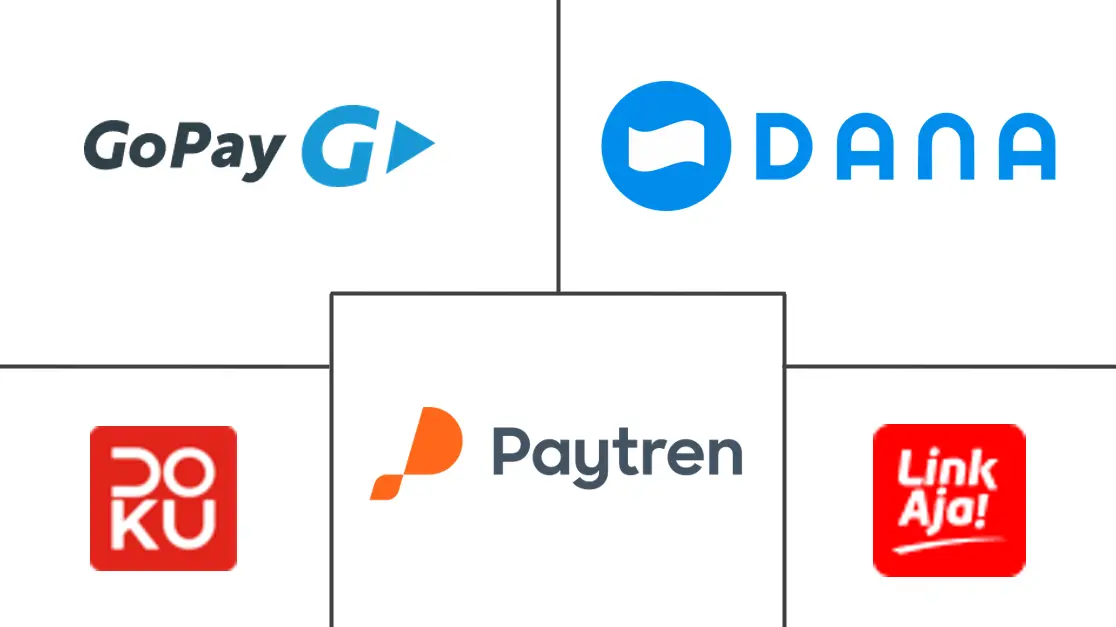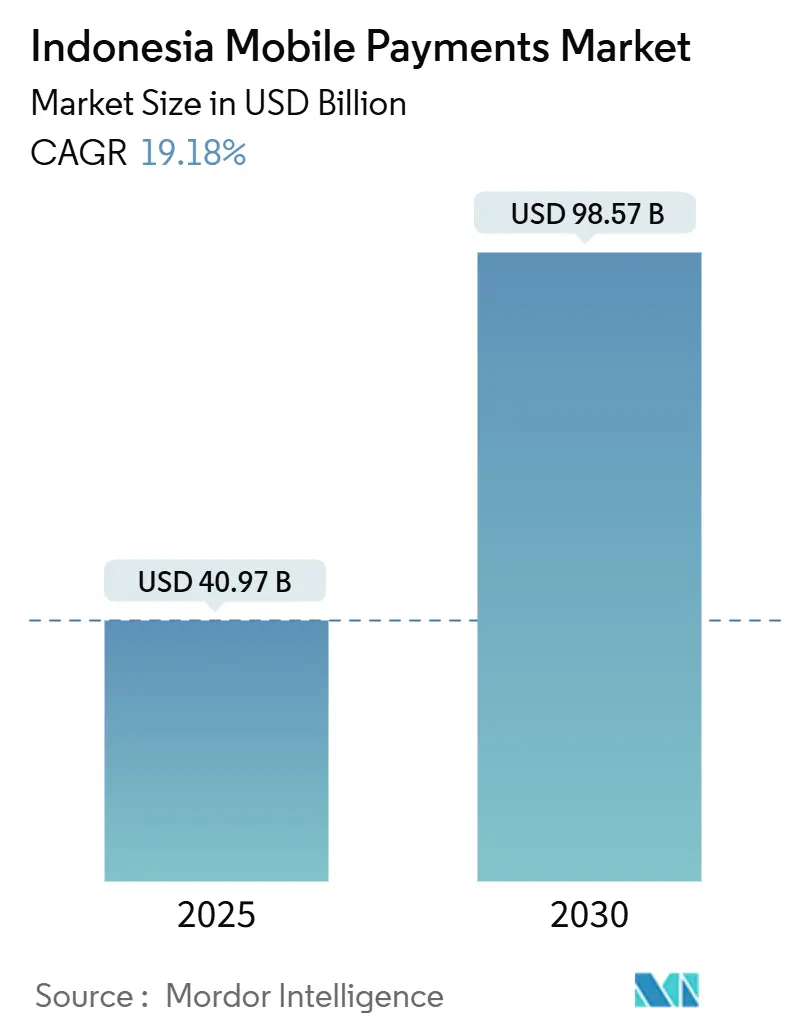
Indonesia Mobile Payments Market Analysis by Mordor Intelligence
The Indonesia mobile payments market is valued at USD 40.97 billion in 2025 and is projected to climb to USD 98.57 billion by 2030, delivering a solid 19.18% CAGR during the forecast window. Rapid merchant on-boarding through the nationwide QRIS standard, the social-commerce surge in tier-2 and tier-3 cities, and government cashless mandates in transportation collectively reinforce the growth profile. Market participants extend wallets with lending, insurance, and remittance features, which widens average revenue per user while deepening ecosystem stickiness. Telco network upgrades and falling data costs improve transaction reliability, although 5G deployment remains cautious because operators weigh demand against spectrum fees. Competitive intensity stays moderate as super-apps race to cement user loyalty ahead of expected consolidation, while traditional banks enhance mobile front ends to protect deposit bases.
Key Report Takeaways
- By payment type, remote payments led with 68.04% of Indonesia mobile payments market share in 2024; proximity payments post the fastest 22.03% CAGR to 2030.
- By transaction type, person-to-merchant flows held 45.07% of the Indonesia mobile payments market size in 2024, whereas in-store POS transactions expand at a 21.46% CAGR through 2030.
- By application, retail and e-commerce captured 38.21% revenue in 2024; transportation and logistics accelerate at a 22.83% CAGR to 2030.
- By end-user, personal accounts dominated with 80.32% share in 2024, while business usage registers a 23.81% CAGR to 2030.
Indonesia Mobile Payments Market Trends and Insights
Drivers Impact Analysis
| Driver | (~) % Impact on CAGR Forecast | Geographic Relevance | Impact Timeline |
|---|---|---|---|
| Bank Indonesia's Nationwide QRIS Mandate Accelerating Merchant On-Boarding | +4.2% | National, with concentrated gains in Java and urban centers | Short term (≤ 2 years) |
| Social-Commerce Boom in Tier-2/3 Cities Expanding Wallet GMV | +3.8% | Regional, focused on secondary cities outside Jakarta, Surabaya, Bandung | Medium term (2-4 years) |
| Government Cashless Incentives in Public Transport (JakLingko) Driving Daily Use-Cases | +2.9% | Jakarta metropolitan area, expanding to other major cities | Medium term (2-4 years) |
| "Buy-Now-Pay-Later" Integration Inside Wallets Raising Frequency & Ticket Size | +3.1% | National, with higher adoption in urban millennials and Gen-Z | Short term (≤ 2 years) |
| BI-FAST Real-Time Transfer Fee Reduction Stimulating Account-to-Wallet Payments | +2.7% | National, particularly benefiting inter-bank transfers | Long term (≥ 4 years) |
| Cross-Border QR Code Linkages with Malaysia & Singapore Boosting Inbound Tourist Spend | +1.5% | Border regions and tourist destinations, Bali, Jakarta | Long term (≥ 4 years) |
| Source: Mordor Intelligence | |||
Bank Indonesia's Nationwide QRIS Mandate Accelerating Merchant On-Boarding
QRIS unifies QR acceptance, eliminating duplicate codes and lowering technical costs for 31.86 million merchants, 95% of whom are MSMEs. Annual QRIS transaction volume jumped 194.06% in April 2024, reinforcing the Indonesia mobile payments market flywheel. A temporary waiver of merchant discount rates on sub-IDR 500,000 (USD 31) tickets boosts rural take-up.[1]Kontan, “BI Waives MDR for Micro QRIS Transactions,” kontan.co.id Greater acceptance enlarges addressable spend, encouraging wallets to innovate credit and loyalty modules that anchor users.
Social-Commerce Boom in Tier-2/3 Cities Expanding Wallet GMV**
Around 124 million urban consumers outside primary metros transact on social-commerce feeds that embed one-click pay buttons, pushing gross merchandise value for wallets.[2]Indosat Ooredoo Hutchison, “Indonesia Digital Economy Outlook 2027,” indosatooredoo.com When TikTok Shop folded into Tokopedia, transactions moved under licensed rails that favor compliant payment networks. The resulting scale widens the Indonesia mobile payments market while lowering acquisition costs.
Government Cashless Incentives in Public Transport (JakLingko) Driving Daily Use-Cases
JakLingko forces daily commuters to tap QR codes for multimodal rides, forming habitual micro-transactions that spill into retail. Bank Indonesia pilots QRIS Tap NFC across 110 vehicles to cut dwell time and enhance throughput. Habit formation elevates frequency metrics that matter for wallet profitability.
Buy-Now-Pay-Later” Integration Inside Wallets Raising Frequency & Ticket Size
BNPL loans grew 42.68% YoY in 2024 as Akulaku and Kredivo partnered with wallets for turnkey credit offers.[3]Otoritas Jasa Keuangan, “2024 Anti-Fraud Strategy Guidelines,” ojk.go.id Embedded scoring based on payment data trims default loss and lets providers monetize interest spread. Higher baskets and repeat use uplift Indonesia mobile payments market revenue density.
Restraints Impact Analysis
| Restraint | (~) % Impact on CAGR Forecast | Geographic Relevance | Impact Timeline |
|---|---|---|---|
| Persisting OTP/Social-Engineering Fraud Undermining Consumer Trust | -2.8% | National, with higher impact in urban areas with greater digital adoption | Short term (≤ 2 years) |
| Fragmented Wallet Ecosystem & Interoperability Gaps Pre-QRIS Roll-out | -1.9% | National, particularly affecting merchant adoption in rural areas | Medium term (2-4 years) |
| High MDR for Micro-Merchants Outside Subsidized Schemes | -1.6% | National, with concentrated impact on rural and small urban merchants | Medium term (2-4 years) |
| Low NFC-Enabled Smartphone Penetration in Rural Indonesia | -1.3% | Rural areas and eastern provinces with limited infrastructure | Long term (≥ 4 years) |
| Source: Mordor Intelligence | |||
Persisting OTP/Social-Engineering Fraud Undermining Consumer Trust
OJK logged 13,229 complaints in 2022, 3,294 linked to payment fraud, eroding confidence among first-time users. Deepfake voice scams target seniors with low digital literacy, prompting costly KYC upgrades by providers. Although BI-FAST embeds mandatory risk controls, incident publicity still dents the Indonesia mobile payments market enthusiasm.
Fragmented Wallet Ecosystem & Interoperability Gaps Pre-QRIS Roll-out
Before 2024, merchants kept five or more wallet integrations, an untenable load outside Java. While QRIS standardizes front-end acceptance, disparate settlement cycles persist. Smaller retailers face cash-flow strain when daily takings clear next-day, delaying full participation in the Indonesia mobile payments market.
Segment Analysis
By Payment Type: Remote Payments Drive Digital Commerce Growth
Remote payments held 68.04% share of the Indonesia mobile payments market in 2024 as archipelagic logistics favored cash-free checkout. Large e-commerce platforms route every purchase through in-house wallets, capturing margin and data. ShopeePay’s dominance mirrors this effect, with 77% of online buyers preferring e-wallets. GoTo and TikTok’s USD 1.5 billion pact to blend video commerce and pay functions raised remote GMV by triple digits in pilot events.
Proximity payments are projected to grow 22.03% CAGR through 2030, powered by QRIS Tap NFC launches on buses and metros. Contactless acceptance removes friction at convenience stores, aligning with post-pandemic hygiene habits. Telcos forecast data monetization as 4G/5G coverage expands, further scaling proximity contributions to the Indonesia mobile payments market.
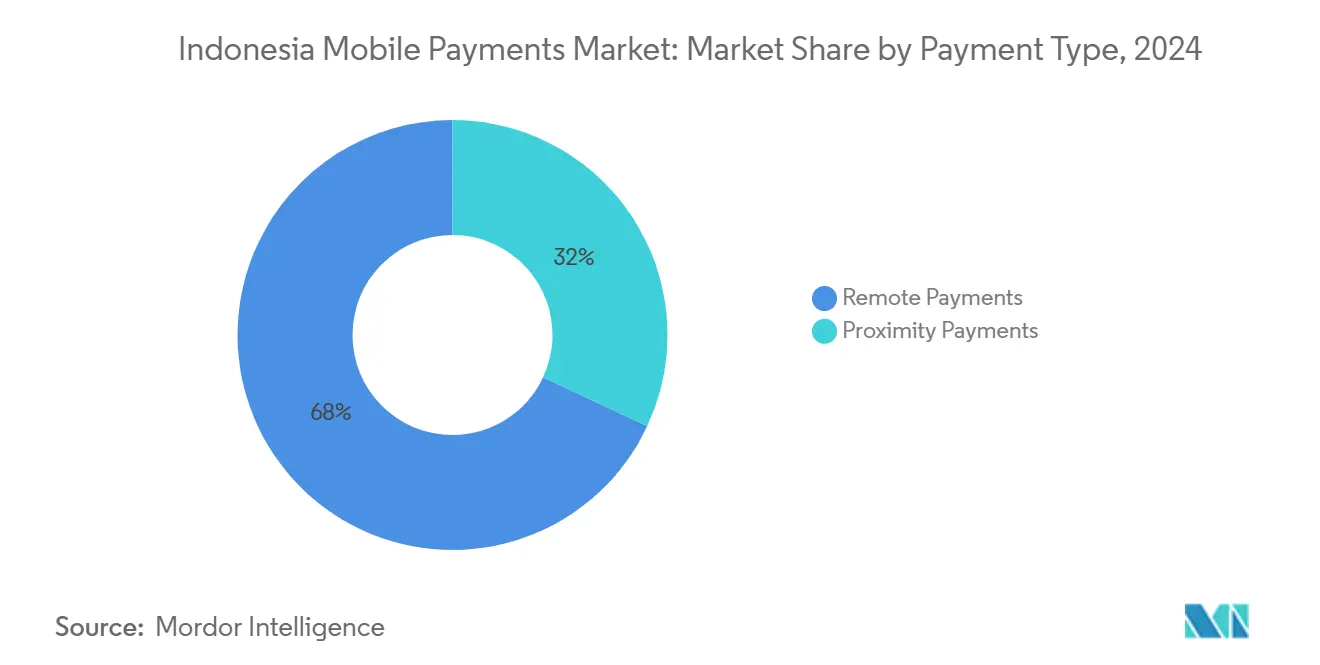
By Transaction Type: P2M Dominance Reflects E-commerce Integration
Person-to-merchant flows commanded 45.07% share in 2024, supported by merchant fee holidays for tickets under IDR 500,000 (USD 30.81). BNPL checkout boosts average order values, while loyalty points incentivize repeat visits.
In-store POS payments chart a 21.46% CAGR to 2030 due to BCA’s multi-settlement feature that lets merchants redeem QRIS funds up to four times daily. Reliable cash-flow visibility reduces resistance among MSMEs and enlarges the Indonesia mobile payments market size for brick-and-mortar sales.
By Application: Transportation Digitization Accelerates Growth
Retail and e-commerce retained 38.21% share in 2024 as Indonesia ranked 8th globally by online sales, worth USD 120 billion. Livestream shopping, cashback festivals, and instant refunds encourage wallet penetration.
Transportation and logistics applications deliver a 22.83% CAGR forward as JakLingko mandates cashless fares. Grab’s ride-hailing integration with the JakLingko super-ticket exemplifies how mobility services seed high-frequency usage and broaden the Indonesia mobile payments market.
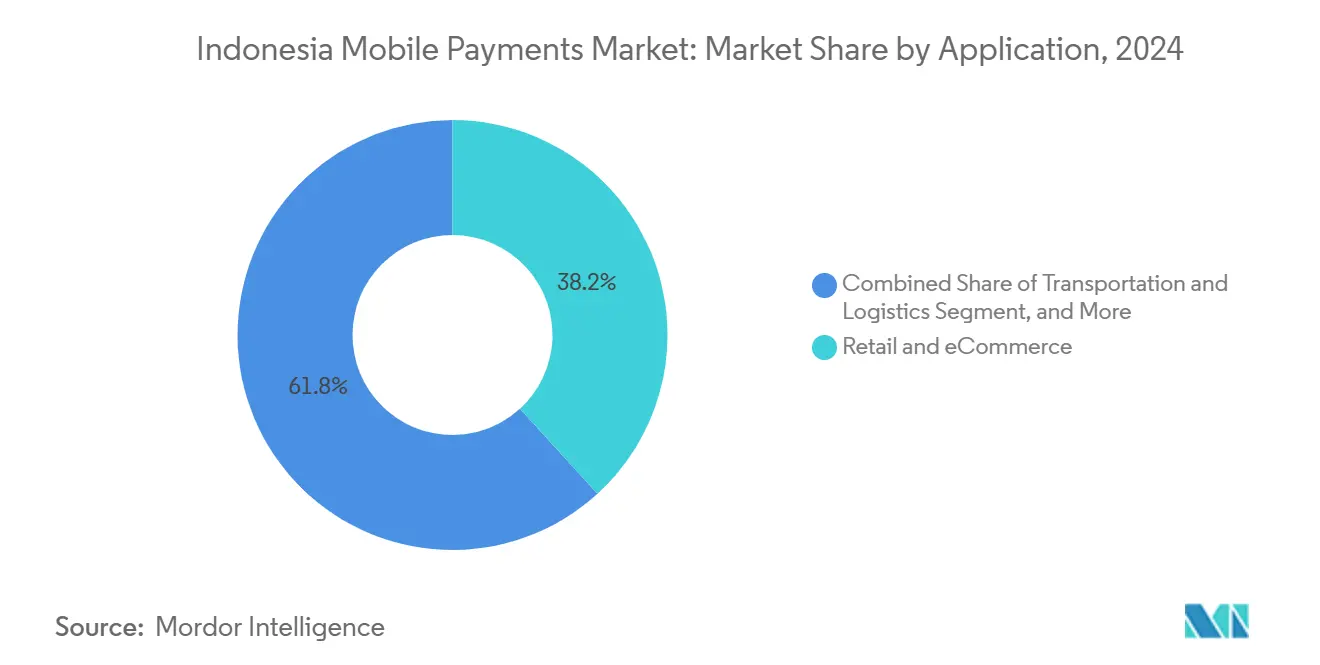
Note: Segment shares of all individual segments available upon report purchase
By End-user: Business Adoption Accelerates Digital Transformation
Personal users accounted for 80.32% of transactions in 2024, benefiting from 96% e-wallet awareness. Cashback and free transfers cement daily reliance.
Business accounts grow 23.81% CAGR as 25.5 million MSMEs migrate online, backed by KUR credit lines and new merchant dashboards from GoPay. Enhanced analytics and automated invoicing lift operational efficiency, unlocking fresh volume in the Indonesia mobile payments industry.
Geography Analysis
Java dominates volume generation thanks to Jakarta’s QR-enabled transport and high 4G density, which cover 97.16% of the population. Surabaya and Bandung replicate use patterns through local government incentives. However, telcos cite limited economic case for rapid 5G roll-out, which may slow advanced NFC or biometric pay features.
Sumatra, Kalimantan, and Sulawesi record the fastest growth as social-commerce expands among 124 million secondary-city dwellers. QRIS lifts merchant readiness despite patchy IT support, narrowing the urban-rural payment gap.
Border provinces leverage ASEAN QR interoperability, letting tourists from Malaysia and Singapore pay with home wallets in Bali’s shops and Riau’s duty-free stores. Eastern regions like Papua and Maluku begin to benefit from satellite broadband and upcoming BI cashless roadshows, signalling long-tail upside for the Indonesia mobile payments market.
Competitive Landscape
Competition is anchored around super-apps that fuse transport, commerce, and finance. GoPay, OVO, DANA, and ShopeePay collectively processed 60% of wallet transactions in 2024. GoTo posted IDR 79.2 trillion (USD 5.2 billion) Q4 2024 GTV, its first tech unit EBITDA profit, proving economies of scale. Grab’s revenue grew 17% YoY to USD 764 million, with loan books up 64%. Banks counter with BRImo and Livin’ to retain deposits, while BCA pilots instant multi-settlement QRIS to serve MSMEs.
Strategic plays emphasize fraud AI, faster settlements, and cross-border rails. OJK’s zero-tolerance fraud edict pressures all providers to invest in behavioural analytics. White-space areas include rural merchant onboarding, school fee payments, and niche healthcare wallets. M&A outlook features potential Grab-GoTo merger talks that could consolidate ride-hailing and delivery volumes; regulators watch concentration risk.
Barriers to entry comprise Bank Indonesia licensing, capital adequacy, and 24/7 system resilience mandates. QRIS has neutralized technical moats, so differentiation shifts toward integrated credit, wealth, and insurance modules that extend user lifetime value within the Indonesia mobile payments market.
Indonesia Mobile Payments Industry Leaders
-
PT Dompet Karya Anak Bangsa (GoPay)
-
PT Espay Debit Indonesia Koe (DANA)
-
PT Nusa Satu Inti Artha (DOKU)
-
PT Fintek Karya Nusantara (LinkAja)
-
PT Veritra Sentosa Internasional (PayTren)
- *Disclaimer: Major Players sorted in no particular order
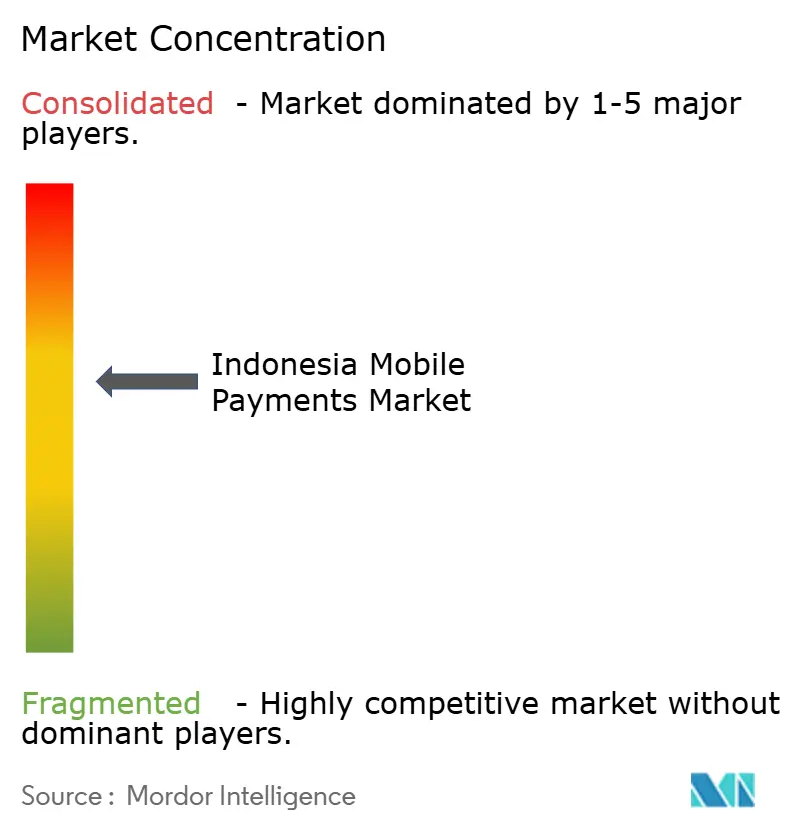
Recent Industry Developments
- January 2025: Bank Indonesia enabled local-currency settlement with UAE, giving wallets a new corridor for trade and remittances. Strategy: diversify FX revenue beyond ASEAN.
- January 2025: OJK Regulation 27/2024 shifted crypto oversight to OJK. Wallets can seek licenses for digital-asset custody, adding fee income.
- December 2024: QRIS Tap NFC pilot launched across 110 vehicles with 14 providers. Strategy: prove sub-second authentication to replicate in retail.
- October 2024: BCA introduced multi-settlement QRIS, shortening merchant cash cycles. Strategy: court MSMEs away from rival wallets.
Indonesia Mobile Payments Market Report Scope
Mobile payment is a payment made for a product or service through a portable electronic device such as a tablet or cell phone. The study tracks the application of mobile payment based on transaction type, which is Proximity and Remote payment. The study tracks key market metrics, underlying growth influencers, and significant industry vendors, providing support for Indonesia's mobile payments market estimates and growth rates throughout the anticipated period. The study looks at COVID-19's overall influence on Indonesia's payment ecosystem.
| Proximity Payments |
| Remote Payments |
| Peer-to-Peer (P2P) |
| In-store Point-of-Sale (POS) |
| Person-to-Merchant (P2M/Checkout) |
| Other Transaction Types |
| Retail and eCommerce |
| Transportation and Logistics |
| Hospitality and Food-Service |
| Government and Public Sector |
| Other Applications (Education, Healthcare) |
| Personal |
| Business |
| By Payment Type | Proximity Payments |
| Remote Payments | |
| By Transaction Type | Peer-to-Peer (P2P) |
| In-store Point-of-Sale (POS) | |
| Person-to-Merchant (P2M/Checkout) | |
| Other Transaction Types | |
| By Application | Retail and eCommerce |
| Transportation and Logistics | |
| Hospitality and Food-Service | |
| Government and Public Sector | |
| Other Applications (Education, Healthcare) | |
| By End-user | Personal |
| Business |
Key Questions Answered in the Report
What is the current size of the Indonesia mobile payments market?
The market stands at USD 40.97 billion in 2025 and is on course to reach USD 98.57 billion by 2030.
Which segment grows fastest within the Indonesia mobile payments market?
Proximity payments, supported by QRIS Tap NFC roll-outs, show a 22.03% CAGR through 2030.
How does government policy influence adoption?
Bank Indonesia’s QRIS mandate, zero MDR for micro-transactions, and JakLingko’s cashless transport system accelerate daily wallet usage.
Why is fraud a critical restraint?
OTP and social-engineering scams cut consumer confidence, subtracting an estimated 2.8 percentage points from forecast CAGR despite ongoing regulatory counter-measures.
What role does BNPL play in market expansion?
Embedded BNPL raises transaction frequency and basket size while opening new revenue streams via interest and merchant fees.
Are cross-border payments available?
Yes, Indonesia’s QRIS is interoperable with Malaysia and Singapore, and Bilateral-Currency Settlement with UAE broadens trade and remittance corridors.
Page last updated on:
